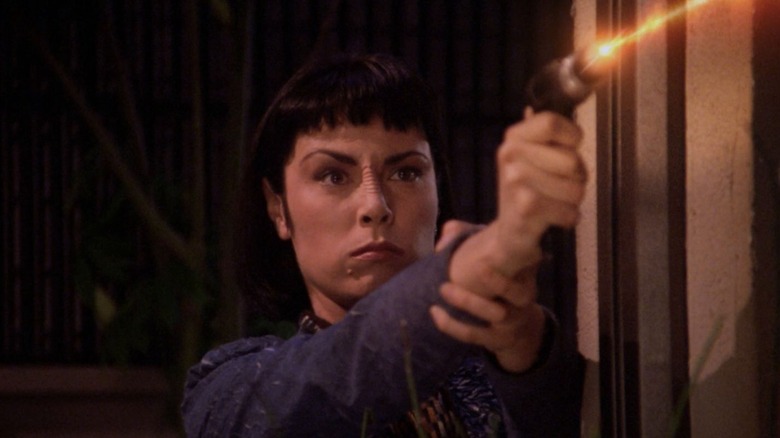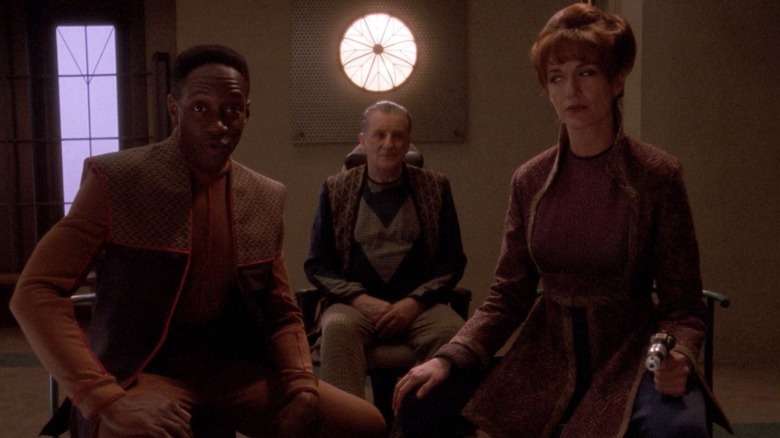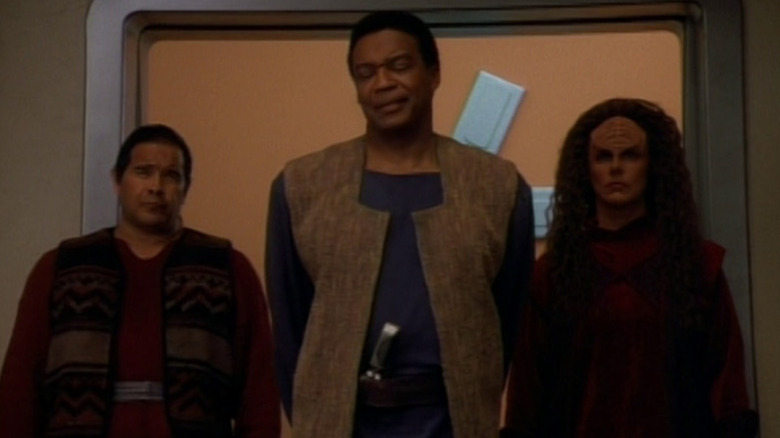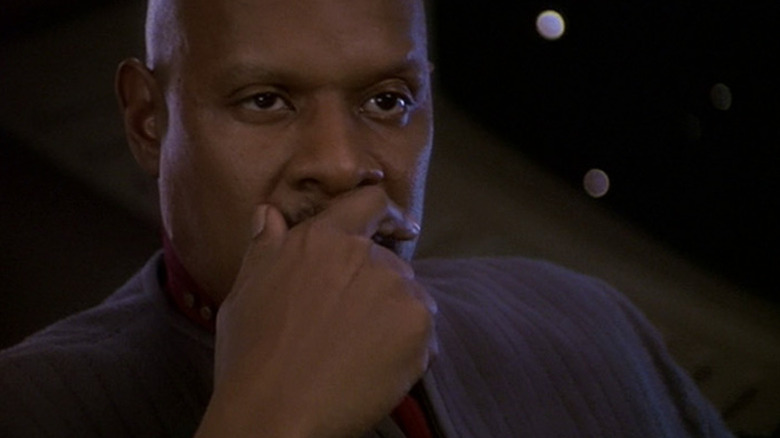Whatever Happened To The Maquis On Star Trek?
The utopia of "Star Trek" isn't always that utopian.
In the universe of "Star Trek," Earth and hundreds of other alien worlds are part of the United Federation of Planets, a mutually beneficial organization devoted to the sharing of resources, the exchange of cultural ideas, and the fomenting of diplomatic relations. There is never war within the federation, as diplomacy has reached the level of super-science, allowing for the absolute avoidance of armed conflict, even between the most cantankerous of neighbors. Starfleet, the widespread, Earth-based space military, provides the ships, manpower, and technology to assure planets stay in contact and that resources are perfectly allocated, all while studying, discovering and learning.
Sadly, even with their peace-loving setup, the Federation often has to deal with non-Federation worlds that are still devoted to money or conquest or military might. Most notoriously, the Federation has often had to deal with the Cardassians, a fascist regime ruled by the military and devoted to the taking and occupation of other worlds. And when the Federation is dealing with the Cardassians, their diplomatic approach can sometimes result in unjust results. Case in point: thanks to a poorly-thought-out treaty, the Federation ceded a great swath of a demilitarized zone back to the Cardassians in the late 2360s. Sadly, there were a great number of Federation colonies in that zone who suddenly found themselves under Cardassian rule.
Many of those colonists had to become a militia against the Cardassians, and came to resent the sloppy, dismissive treatment of the Federation. The freedom-fighting militias organized into The Maquis. The Maquis aimed to fight off the Cardassians, and form their own independent state, free from Federation oversight. There aren't too many malcontents in the world of "Star Trek," but the Maquis were most certainly malcontent.
The Maquis were introduced on Star Trek: The Next Generation
The Maquis were first introduced in the "Star Trek: The Next Generation" episode "Preemptive Strike" (May 16, 1994), the second-to-last episode of the series. The Maquis were meant to become key players in the concurrent series "Star Trek: Deep Space Nine," and would become a large part of the soon-to-launch "Star Trek: Voyager." "Preemptive Strike" focused mainly on the character of Ro Laren (Michelle Forbes) a Bajoran whose planet underwent a lengthy Cardassian occupation, and which only recently shook off their occupiers. When the Maquis arose, complaining that they were suddenly under Cardassian rule, Ro felt a sudden kinship with them. Ro was assigned to infiltrate the Maquis to get information — the Federation considered them to be traitors — but she became sympathetic to their cause and could provide actual, helpful tactics. The episode ended with Ro leaving the Enterprise, abandoning the Federation, and becoming a Maquis fighter.
Ro's betrayal deeply wounded Captain Picard (Patrick Stewart), as he had spent years witnessing her turn into a better and better officer. Ro's betrayal, though, was also a wake-up call from the Trekkies watching. Diplomacy, we learned, was tricky, and the Federation can make bad decisions. If the Federation aided the Maquis and tried to fight for their colonies, the Federation would risk the ire of the already trigger-happy Cardassians. Instead, they decided to apprehend their own citizens and leave Cardassia to their own space. Unfortunately, in practice, that looks like the Federation is committing violence and arrests on behalf of the Cardassians.
It was a weird final note to leave the show on before its finale episode, the following week.
The Maquis were recurring antagonists on Star Trek: Deep Space Nine
The Maquis, as mentioned, were to become larger players on "Star Trek: Deep Space Nine," a series that more heavily involves the Cardassians and the Bajorans. "Deep Space Nine," as Trekkies can tell you, was set on board a Cardassian-built space station orbiting the planet Bajor, with the station serving as a key tool in the planet's long, arduous reconstruction. The Cardassians, because they are so insidious, were always lurking nearby, ready to re-occupy Bajor should the government fail again.
With that setup, naturally the Maquis would find allies. The Maquis first appeared on "Deep Space Nine" in the episode called, well, "The Maquis" (April 24, 1994), a two-parter wherein Commander Sisko (Avery Brooks) had to witness a close colleague, Captain Cal Hudson (the great Bernie Casey) defect to the rebels. Sisko had to team up with the show's central villain, Gul Dukat (Marc Alaimo) to find the truth about the Maquis, and to interrupt an arms deal. Sisko points out that the Maquis have every right to resent the Federation for being abandoned to the Cardassians, but that their military maneuvers against Starfleet are less about political statements and more about rage and revenge. The episode ends on an ambivalent note, with Sisko wondering if he was able to solve the Maquis' conflicts, or just delay the inevitable violence.
The Maquis turned up periodically throughout "Deep Space Nine," serving as an opposition force through the show's sixth season. "Deep Space Nine" was a hugely dramatic show that eventually erupted into a galactic war between the Federation and the Dominion, a military force from the Gamma Quadrant. When the Dominion teamed up with the Cardassians, all hell broke loose for the Maquis.
The Maquis were part of the crew on Star Trek: Voyager
"Star Trek: Voyager" debuted in January of 1995, and began with a tantalizing premise surrounding the Maquis. The U.S.S. Voyager was chasing a Maquis vessel, locked in combat, when both ships were suddenly and unexpectedly whisked clear across the galaxy by an all-powerful god alien. Everyone found themselves in the Delta Quadrant, a full 70 years away from Earth. The god alien died, and the Maquis ship was destroyed, stranding them all, and forcing the Maquis to live on the Voyager. Captain Janeway (Kate Mulgrew), as a show of goodwill, decided to let the Maquis become provisional officers, hoping everyone could live together.
From the Maquis, Chakotay (Robert Beltran) became the ship's first officer, B'Elanna Torres (Roxann Dawson) became the chief engineer, and other ancillary Maquis members became officers besides. The idea was that the headbutting between Starfleet and the Maquis would generate a slew of new stories. Sadly, "Voyager" never quite took full advantage of that setup, having the Maquis members get along with Starfleet pretty much from the first episode on. They were awfully quick to put on those Starfleet uniforms. The Maquis were mentioned throughout "Voyager," of course, but any kind of conflicts were pretty much solves.
The biggest dramatic wrinkle came later in the series when the U.S.S. Voyager has gotten close enough to Earth to start trading long-distance communications (via a widespread alien communications array). It had been years, and one of the first pieces of information they get is that most of the Maquis had been wiped out by the Dominion and the Cardassians. This was especially hard on B'Elanna Torres who was shocked by how not-depressed the news made her.
The Maquis were wiped out almost completely during the Dominion War
So what happened to the Maquis? Sadly, they were pretty much all killed. In the "Deep Space Nine" episode "By Inferno's Light" (February 17, 1997), we see the Cardassians join up with the ultra-powerful Dominion, causing no small amount of consternation with Captain Sisko. Gul Dukat now had a giant fleet of Dominion soldiers — the Jem'Hadar — at his command. The new alliance caused the Federation to form a military alliance with the Klingons, in the hope that their combined might would dissuade Dukat from doing anything rash.
Dukat, however, is too energized by his new military power, and vows to wipe out all the Maquis colonies in Cardassian space within the next 36 hours. With the Jem'Hadar warships at his beck and call, Dukat is shocking efficient at fulfilling this promise. All the Maquis are pretty much wiped out, leaving only straggling members with no powers or equipment to resist. The only surviving members of the Maquis were either in Federation prisons, or on board the U.S.S. Voyager, thousands of lightyears away.
Although that's a tragic end, many Trekkies might have something of a cynical view of the Maquis, pointing out that they were never exploited to their full potential. They could have been the brave Rebels against an "Evil Empire," only the Evil Empire is a gentle utopia that Trekkies love. It would have made for a good moral counterpoint. Sadly, the many "Star Trek" writers never really got to exploit that clash of ideas in a meaningful way. The Maquis never really emerged as anyone's favorite characters on "Star Trek." They're more of a footnote now.
It's a pity, because they started out with something to say.




